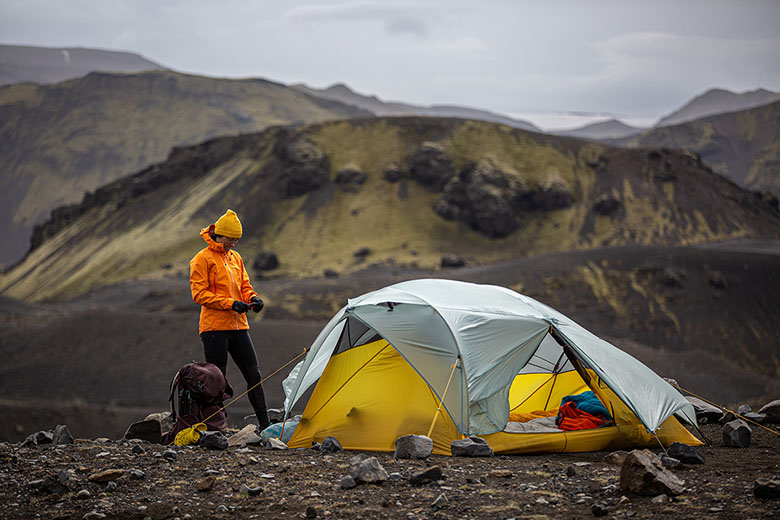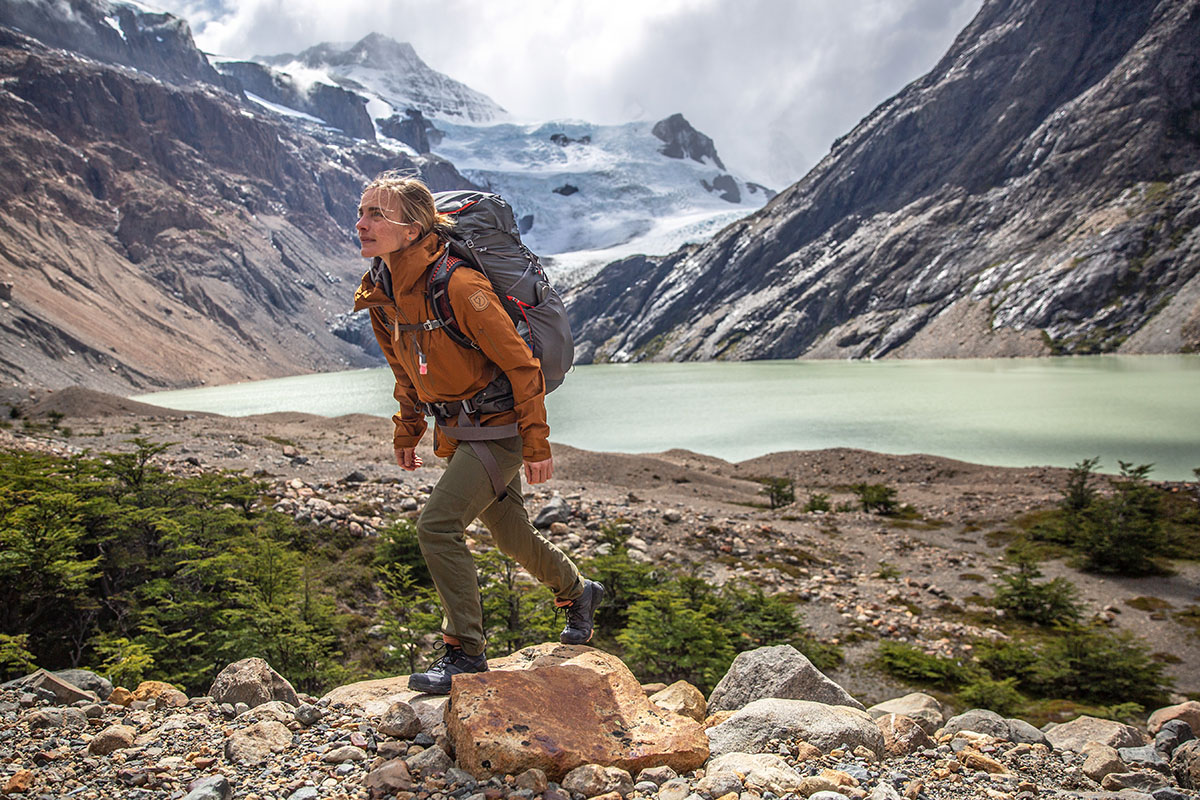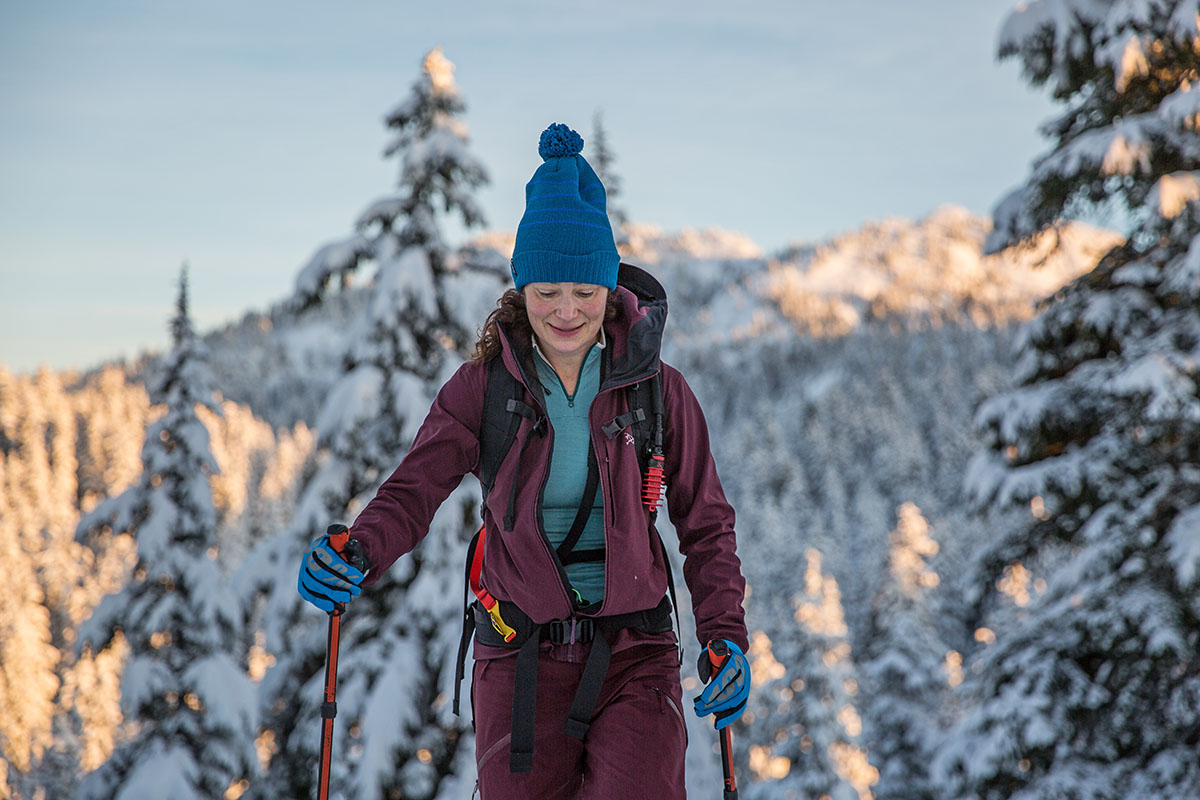

A common debate amongst backcountry-goers is whether to wear a hardshell or softshell jacket as an outer layer. Both types have areas in which they shine: Hardshells excel in extreme conditions, while softshells are generally breathable, stretchy, and soft to the touch. Predictably, each makes sense in very different conditions. To help you choose the best option, below we break down the pros and cons of each type based on multiple different factors. And for a look at our current favorites in each category, check out our detailed guides of the best hardshell jackets and best softshell jackets.
Editor's note: This article was updated on July 26, 2024, to revise some of our product recommendations and ensure all information—including product specifications and prices—was correct at the time of publishing.
As the name indicates, hardshell jackets are rigid and stiff. This is because they’re designed to be your primary layer of defense against whipping winds and heavy precipitation. You can think of a hardshell as a step up from a rain jacket, with thicker and more impermeable fabrics, reinforced seams, and more substantial hoods. For those days when nothing can keep you inside (not even Mother Nature), a hardshell is your best friend.

It’s important to note that there’s no industry-wide definition of a hardshell, but there are a number of common features that gear companies use to define this type of jacket. In terms of construction, hardshells all share a 3-layer build: A waterproof and breathable membrane is sandwiched between an interior liner and durable exterior face fabric. The most common membrane type is Gore-Tex, although you'll see eVent or Polartec NeoShell designs on occasion. Further, some notable in-house builds include Outdoor Research's AscentShell, Patagonia's H2No, and The North Face's Futurelight. To finish things off, hardshells will often have taped seams and a water-repellant DWR finish. The result? A fully water- and windproof jacket that will keep the elements at bay as you venture into biting gusts and heavy rain or snow.

A softshell, as its name states, is a cozy and pliable outer layer. Softshell jackets feature a durable nylon or polyester face fabric and an ultra-comfortable interior—often made out of brushed polyester or fleece. These stretchy jackets place a high priority on mobility and breathability, which translates to solid comfort during activity and a pliable shell that avoids the “crinkly” feel common among hardshells. You also get solid wind resistance and a DWR finish that deftly sheds light rain and snow, making these jackets great for mountain environments. However, without a waterproof membrane, you don’t get the same level of wet-weather protection as you do with a hardshell.

There’s no universally accepted definition of hardshells or softshells, so naturally, some jackets fall somewhere in between the two. A shell that’s soft and stretchy on the outside might also have a waterproof membrane in the middle. Tack on seam-taping and a DWR coating, and the result is a jacket that combines the waterproofing of a hardshell with the comfort of a softshell. The Rab Kinetic 2.0 is a prime example, featuring a 3-layer Proflex shell with soft and pliable fabrics built for movement.
What’s the downside to these hybrid jackets? In short, the jack of all trades is always the master of none. By adding a waterproof membrane, you compromise some of the breathability that many seek out in a softshell. On the other hand, adding stretch-woven fabric to a hardshell increases the weight and packed size. These hybrid jackets certainly have their place (after all, who wouldn’t want a stretchy hardshell or a waterproof softshell?), but it’s important to be aware of the downsides when making your decision.

If there’s one thing that defines hardshells, it’s unparalleled weather protection. Both softshells and hardshells have burly constructions and water-resistant finishes, but hardshells tack on a waterproof membrane for a bombproof defense against moisture. Thus, while a softshell does a decent job at resisting wind and sluffing off light rain or snow, a hardshell is built for all-day protection in the wettest of weather. Further, most hardshells feature more comprehensive head-to-hip protection, including helmet-compatible hoods, tall collars, and drop-tail hems. Even under clear skies, many backcountry-goers will appreciate a hardshell’s impervious nature while digging data pits, constructing snow shelters, or getting up from an unexpected fall in powder.

Just as hardshells excel at weather protection, softshells offer impressive breathability. Without the added barrier of a waterproof membrane, body heat can easily escape from a softshell, making it a great option for high-intensity activities. We know many climbers and backcountry skiers who love softshells for their ability to breathe while they’re working hard in the mountains but still provide insulation when they stop to remove climbing skins, transition, or wait for their pals to catch up. Hardshells, on the other hand, are more likely to trap your body’s heat during activities like skinning, snowshoeing, or hiking, causing a buildup of perspiration on your skin and baselayers. In winter specifically, it’s important to prevent heavy sweating—hypothermia can set in quickly once you stop moving and that sweat freezes.

If you’re hellbent on a hardshell but want a modicum of breathability, the good news is that some waterproof membranes are more breathable than others. For example, Gore’s “Active” is more trimmed-down and lighter than their top-of-the-line “Pro,” which allows more air to escape. Among Gore-Tex competitors, eVent offers a noticeable bump in breathability, and Polartec NeoShell and Outdoor Research’s AscentShell are also more air-permeable, but all lack the same level of durability and weatherproofing as Gore’s Pro laminate. Finally, some hardshells do have vents or pit zips, but these aren’t a true substitute for good breathability.
In general, hardshells are lighter than softshells, which makes them appealing for long days on the skin track, multiday backpacking trips, and other big mountain adventures. For example, our top-rated hardshell, the Arc’teryx Beta AR, comes in at just a smidge over 1 pound, which is about average. Most of our favorite softshells weigh in well above this, falling between around 15 ounces and 1 pound 10 ounces with thicker fabrics and fleece liners. Predictably, this also affects packability: Hardshells are generally more compact and stuff into a pack more easily than softshells. It is important to note, however, that there are an increasing number of lightweight softshell jackets (the Black Diamond Alpine Start, for example), which are a great option for backcountry-goers willing to give up some warmth and weather protection to save on weight.

Hardshells and softshells share the podium when it comes to durability, with robust materials designed for heavy use. Most hardshells are built with rigid face fabrics ranging from about 20- to 80-denier (the higher the number, the heavier and more bomber the shell will be). On the other hand, softshells use thick, stretchy fabrics to guard against wear and tear. Keep in mind that with both styles, the thinner you go, the less durability you get. This is especially true with rigid hardshells, while the built-in stretch of a thin softshell helps protect it against abrasion (to a degree).

When it comes to comfort, softshell jackets are the clear winners. After all, it's hard to argue with soft and stretchy fabric, and many softshells also feature fleece liners for additional next-to-skin coziness. Hardshells, on the other hand, are generally more rigid, with loud, crinkly fabrics and less overall mobility. Some hardshells include stretch or a soft knit backer, but even these designs can't match the comfort of a true softshell.

If you’re looking to save money, a softshell will be much easier on your wallet—even top-of-the-line softshells are much cheaper than hardshells. For example, most of our favorite hardshells hover around $400 to $500, with many exceeding $600 (the Arc’teryx Alpha SV is a whopping $900). On the flip side, the most expensive softshell we feature is the $400 Arc’teryx Gamma MX Hoody—and most are considerably less than that. This isn’t exactly comparing apples to apples—softshells and hardshells have very different priorities, so it makes sense that they differ greatly in cost. But for a layer that can be used as an outer shell for active winter sports, a midlayer on rainy or blustery days, or just a wear-around-town jacket, we think a softshell is still the better deal.

In the end, choosing a high-performance shell comes down to conditions and activity level. The good news is that both hardshells and softshells are completely viable options for mountaineering, skiing, snowshoeing, hiking, and climbing. A hardshell will be the best option for days of heavy precipitation and high winds, while a softshell will be better for mild days when dumping heat while traveling fast or uphill (or both) is the goal. In our experience, the more familiar we’ve become with our gear and the conditions we’ll be heading into, the more we find ourselves reaching for a softshell above all else (or even a stretchy windbreaker jacket). It might not be fully water- or windproof, but its stretch and comfort make it a lot more enjoyable to wear all day long. And realistically, those who spend a lot of time outdoors will eventually have at least one of each type of shell in their quiver.

Once you have a better idea of which type of shell is best suited to your needs, you can begin to narrow down your search. To help, we’ve compiled lists of our favorite hardshell and softshell jackets, including helpful comparison tables and buying advice. Below are our top picks in each category, from budget-friendly options for those looking to save to feathery and highly packable designs for fast-and-light enthusiasts.
Best Overall: Arc’teryx Beta AR men's / Arc'teryx Beta AR women's
Best Budget: Outdoor Research MicroGravity men's / Outdoor Research MicroGravity women's
Best for Extreme Conditions: Arc’teryx Alpha SV men's / Arc'teryx Alpha SV women's
Best Ultralight and Packable: Patagonia Storm Racer men's / Patagonia Storm Racer women's
Best Overall: Arc’teryx Gamma Hoody men's / Arc'teryx Gamma Hoody women's
Best for Backcountry Skiing: Black Diamond Dawn Patrol men's
Best Budget: Outdoor Research Ferrosi Hoody men's / OR Ferrosi Hoody women's
Best Ultralight and Packable: Black Diamond Alpine Start men's / BD Alpine Start women's
Best Casual: The North Face Apex Bionic 3 men's / The North Face Apex Bionic 3 women's
Back to Our Hardshell vs. Softshell Guide See Our Ski Gear Reviews